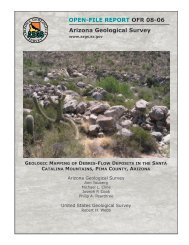land subsidence and earth fissures in arizona - The Arizona ...
land subsidence and earth fissures in arizona - The Arizona ...
land subsidence and earth fissures in arizona - The Arizona ...
Create successful ePaper yourself
Turn your PDF publications into a flip-book with our unique Google optimized e-Paper software.
LAND SUBSIDENCE & EARTH FISSURES IN ARIZONA<br />
7 RECOMMENDATIONS<br />
Mitigat<strong>in</strong>g hazards of <strong>subsidence</strong> <strong>and</strong> <strong>earth</strong> <strong>fissures</strong> requires diligent monitor<strong>in</strong>g <strong>and</strong> the advent<br />
of new <strong>and</strong> effective models that <strong>in</strong>corporate historical <strong>and</strong> cont<strong>in</strong>uous observations <strong>in</strong> robust<br />
analytical techniques to foster new approaches to this problem. Pioneer<strong>in</strong>g eng<strong>in</strong>eer<strong>in</strong>g <strong>and</strong><br />
geoscience studies are required to p<strong>in</strong>po<strong>in</strong>t data requirements <strong>and</strong> construct heuristic models to<br />
illum<strong>in</strong>ate the underly<strong>in</strong>g physical processes. Equally important is the need for a complementary<br />
<strong>and</strong> groundbreak<strong>in</strong>g effort to identify <strong>and</strong> test eng<strong>in</strong>eered structures that promote human health<br />
<strong>and</strong> safety. <strong>The</strong>re exists, too, a compell<strong>in</strong>g need to obta<strong>in</strong>, warehouse, <strong>and</strong> dissem<strong>in</strong>ate relevant<br />
data to the community at large.<br />
Recommendation 1: Encourage research centers to embrace concentrated research on<br />
<strong>subsidence</strong> <strong>and</strong> <strong>earth</strong> <strong>fissures</strong> <strong>in</strong> <strong>Arizona</strong>.<br />
What are desperately needed are research centers or groups dedicated to further<strong>in</strong>g studies<br />
<strong>in</strong>to <strong>subsidence</strong>-related phenomenon <strong>and</strong> associated hazards. <strong>The</strong> National Science<br />
Foundation, the National Institute of Health, <strong>in</strong>dividual States, <strong>and</strong> philanthropic foundations <strong>and</strong><br />
bus<strong>in</strong>esses have provided <strong>in</strong>itial fund<strong>in</strong>g to research centers undertak<strong>in</strong>g cutt<strong>in</strong>g-edge <strong>and</strong><br />
focused research. As an example, the University of <strong>Arizona</strong> has obta<strong>in</strong>ed several of these<br />
centers over the past decade <strong>and</strong> has operated them successfully (e.g., Water Resources<br />
Research Center, Water Quality Center). In <strong>Arizona</strong>, the public universities are particularly well<br />
suited to host <strong>and</strong> nurture research centers for <strong>subsidence</strong> <strong>and</strong> <strong>earth</strong> <strong>fissures</strong> because of the<br />
variety <strong>and</strong> quality of their current research facilities, faculty, staff <strong>and</strong> students. Dr. Muniram<br />
Budhu’s <strong>Arizona</strong> Geohazards Research Center at the University of <strong>Arizona</strong> is a model of a<br />
university-based research center that may be capable of meet<strong>in</strong>g the identified needs.<br />
Dedicated research centers will fill a dire need that can not otherwise be met by operations<br />
with<strong>in</strong> state agencies or by private entities. Centers would partner with state agencies (e.g. the<br />
<strong>Arizona</strong> Geological Survey, the <strong>Arizona</strong> Department of Water Resources) <strong>and</strong> the private sector<br />
to br<strong>in</strong>g high quality research <strong>in</strong>formation to the community at large. In addition to collaborat<strong>in</strong>g<br />
with local, state <strong>and</strong> federal agencies, <strong>and</strong> utilities <strong>and</strong> private companies, research centers are<br />
magnets for attract<strong>in</strong>g external fund<strong>in</strong>g, highly-tra<strong>in</strong>ed personnel, <strong>and</strong> the k<strong>in</strong>ds of crossdiscipl<strong>in</strong>ary<br />
synergy required to address complex problems that extend across scientific fields.<br />
Fortunately, the expertise required can be found <strong>in</strong> the many departments that comprise a<br />
university, such as geosciences, hydrology <strong>and</strong> water resources, environmental science, civil<br />
eng<strong>in</strong>eer<strong>in</strong>g, law, <strong>and</strong> public plann<strong>in</strong>g <strong>and</strong> adm<strong>in</strong>istration. <strong>The</strong> resources <strong>and</strong> expertise available<br />
at <strong>Arizona</strong>’s universities are not to be found (or cobbled together) from state agencies or private<br />
consult<strong>in</strong>g firms.<br />
<strong>The</strong> mission of a <strong>subsidence</strong> <strong>and</strong> <strong>earth</strong> fissure research center, as perceived by ALSG, is to<br />
conduct research on associated geohazards <strong>and</strong> their impacts on eng<strong>in</strong>eered <strong>and</strong> noneng<strong>in</strong>eered<br />
facilities, to dissem<strong>in</strong>ate center studies, <strong>and</strong> to educate technical professionals,<br />
citizens <strong>and</strong> officials <strong>in</strong> <strong>Arizona</strong>. An early goal is to quantify the magnitude of <strong>subsidence</strong> <strong>and</strong><br />
the proliferation of <strong>earth</strong> <strong>fissures</strong> as a function of groundwater withdrawal.<br />
Through research <strong>in</strong>to patterns of groundwater decl<strong>in</strong>e, <strong>l<strong>and</strong></strong> <strong>subsidence</strong>, subsurface<br />
stratigraphy, <strong>and</strong> geomechanics of aquifer materials, a research center can build models to<br />
predict the real extent <strong>and</strong> magnitude of <strong>subsidence</strong>, <strong>and</strong> explore physical thresholds on <strong>earth</strong><br />
fissure formation. This, of course, requires a multidiscipl<strong>in</strong>ary approach beyond what any s<strong>in</strong>gle<br />
state agency could provide. Moreover, the collaborative environment native to research centers<br />
bolsters efficacious <strong>in</strong>formation distribution <strong>and</strong> idea shar<strong>in</strong>g via conferences <strong>and</strong> symposia.<br />
ARIZONA L<strong>and</strong> Subsidence Group December 2007 16

















